Member
Joined 2009
Paid Member
When I said 'corner horn' above, I meant something specifically designed to sit flush/tight into the corner, sorry if I wasn't specific. I can see why one has to be careful about the use of the term though, it hadn't crossed my mind that it equally refers to horns like the FH3 which do benefit from placement near the walls.
Anyhow, the Decware corner horn was the other one I remember looking at, I don't see many people building it. It was popular half a dozen years ago. Maybe it's not that good, or the fact that the plans are not free have killed it off. The horn that is the subject of this thread looks like it would be very difficult to construct without some further innovation - I could see perhaps that some compromises might be made which would make it easier to build, such as...
Instead of concrete use plywood, built up in thickness
Instead of plaster curves, approximate with plywood
With some changes like this the design could have some real 'legs' in DIY circles.
Anyhow, the Decware corner horn was the other one I remember looking at, I don't see many people building it. It was popular half a dozen years ago. Maybe it's not that good, or the fact that the plans are not free have killed it off. The horn that is the subject of this thread looks like it would be very difficult to construct without some further innovation - I could see perhaps that some compromises might be made which would make it easier to build, such as...
Instead of concrete use plywood, built up in thickness
Instead of plaster curves, approximate with plywood
With some changes like this the design could have some real 'legs' in DIY circles.
Last edited:
Don't forget that Voigt had some specific needs for this design; it is a compound horn (with indirect radiation from the front of the driver at that), not a back-load like the Decware when used with a wideband driver. Recording BWs at the time & playback devices were much more limited than they are now; the drivers employed also had considerable peaking at the upper end of their operative BW, hence indirect loading of the front was beneficial in helping to attenuate this somewhat. And so on. The same peaking through that region is a continuing trait in some current Lowthers & has become something of a defining characteristic, for better or worse. The irony being that used as intended, in horn such as the one described here, there wouldn't be much left. It's only when you get the direct radiation off the driver that it becomes so apparent.
The only other corner horn I've seen is the Decware, which looks MUCH easier to build - how do these two compare with each other ?
Anyhow, the Decware corner horn was the other one I remember looking at, I don't see many people building it. It was popular half a dozen years ago. Maybe it's not that good, or the fact that the plans are not free have killed it off.
Hello Bigun, I combined two of your questions into one comment. Having built a set of Decware corner horns, I am pretty sure that they ARE much easier to build than the Voigts. No concrete, no plaster (although a bit of Bondo) amd no curved panels. The narrative mentions having 330 construction hours in the pair.
I had about 40 hours into my two Decware horns built to rather industrial standards, not cabinet maker quality. A friend built his own set after hearing mine. His are solid ash lumber to match the flooring and cabinets in his house. They are gorgeous. The sound quality is excellent. I have had about 100 hi-fidelity people stop by to listen to mine. Most have said that they are the cleanest sounding speakers that they have ever heard. I was contacted by a man who read one of my earlier postings. He had inherited a set of Klipse corner horns and had questions about setting them up, so I visited him and he visited me and we compared our systems. What a difference!
About the only thing that the two types of speakers had in common was that they were both big and sat in corners. The Klipse are powerful. They have big heavy bass speakers and they sound HEAVY. Really heavy. The Decs have little 6 inch round banana skin cones that sounds like they are directly coupled to the phonograph needle. Think sport bike vs Winnebago. Think Bambi vs Godzilla. It would be interesting to know how the Voigt's compare. Why aren't there more Dec's built or any other corner horns built? They are big and need corners and they weigh a lot, more than 100 pounds each. They are hard to assemble with all the steep angle cuts required and if you have large hands, you may not be able to build them. It's tight in there. DecWare had the factory versions listed at $3500. I doubt that they could build them for that. I had $350 in mine including Fostex's.
I have had a long time fascination with horns. I have listened to quite a number of them, built various types and helped build others. The one thing that is important is that they are big. It is just physics. To get low frequencies out of them they need a large mouth area. Even in corners, they need at least a dozen square feet to get down to 50 hz. I have not heard a Voigt, but at least it is big enough to function correctly. And they are beautiful.
This thread makes me wonder if it would be possible to make a simplified version of the DCH?
Doing a front loaded horn for most of frequencyrange and with omni characteristics, seems an overlooked and interesting prospect.
Sans the concrete thingy, curved tractrix and plaster reflector there isn't much in it that you wouldn't be able to do with plain straight plywood.
- Use an up-firing driver instead of the concrete reflector chamber.
- Use two pieces of ply at a 90 to 60 degrees angle and again this angled piece slanted at 45 degrees above the horn. This would go ca. 90 percent of the way towards the plaster reflector.
- Linear horn, maybe with a karlson slot or holes to simulate a more tractrix-like or exponential expansion.
The horn could be triangular in x-section to be more friendly to midrange and highs and fit in the corner.
With a modern driver I think this would get you something close to or maybe even better than the original design.
Doing a front loaded horn for most of frequencyrange and with omni characteristics, seems an overlooked and interesting prospect.
Sans the concrete thingy, curved tractrix and plaster reflector there isn't much in it that you wouldn't be able to do with plain straight plywood.
- Use an up-firing driver instead of the concrete reflector chamber.
- Use two pieces of ply at a 90 to 60 degrees angle and again this angled piece slanted at 45 degrees above the horn. This would go ca. 90 percent of the way towards the plaster reflector.
- Linear horn, maybe with a karlson slot or holes to simulate a more tractrix-like or exponential expansion.
The horn could be triangular in x-section to be more friendly to midrange and highs and fit in the corner.
With a modern driver I think this would get you something close to or maybe even better than the original design.
After thinking about the Voigt Domestic Corner Horn since the 2013 article, I finally have the basic skills to attempt modeling up and building a half scale speaker. Since there was no available build plans nor dimensions, most everything were "interpreted" from internet pictures or made-up.
The 3D model looked good in the computer. For real fabrication, had to modify just about everything.
The molds for the concrete reflectors were 3D printed. The material of choice was baltic birch plywood. The top reflector and horn were glued up from cut plywood. Drivers are Fostex FE83-Sol.
The 3D model looked good in the computer. For real fabrication, had to modify just about everything.
The molds for the concrete reflectors were 3D printed. The material of choice was baltic birch plywood. The top reflector and horn were glued up from cut plywood. Drivers are Fostex FE83-Sol.
Attachments
-
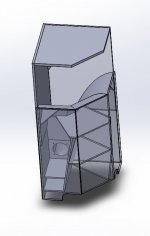 Left_Top.JPG31.6 KB · Views: 371
Left_Top.JPG31.6 KB · Views: 371 -
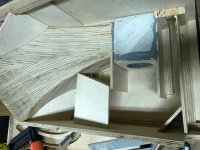 IMG_4380.jpg97.3 KB · Views: 366
IMG_4380.jpg97.3 KB · Views: 366 -
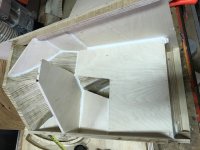 IMG_4381.jpg85.6 KB · Views: 359
IMG_4381.jpg85.6 KB · Views: 359 -
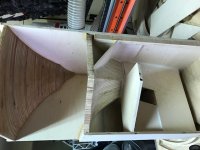 IMG_4382.jpg82.8 KB · Views: 350
IMG_4382.jpg82.8 KB · Views: 350 -
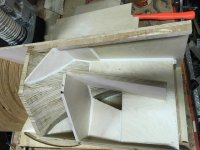 IMG_4384.jpg120.2 KB · Views: 353
IMG_4384.jpg120.2 KB · Views: 353 -
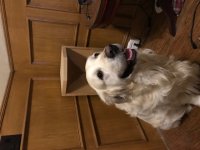 IMG_4393.jpg67.8 KB · Views: 161
IMG_4393.jpg67.8 KB · Views: 161 -
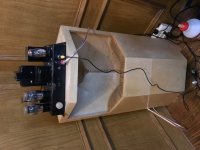 IMG_4427.jpg80.2 KB · Views: 180
IMG_4427.jpg80.2 KB · Views: 180 -
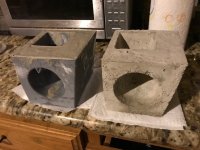 IMG_4342.jpg92.9 KB · Views: 179
IMG_4342.jpg92.9 KB · Views: 179 -
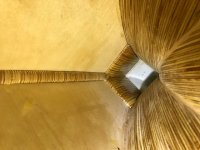 IMG_4407.jpg80 KB · Views: 176
IMG_4407.jpg80 KB · Views: 176 -
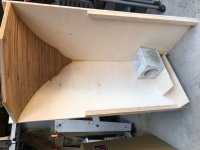 IMG_4361.jpg71.1 KB · Views: 171
IMG_4361.jpg71.1 KB · Views: 171
Something that might be of interest to members on this thread can be found at a site called Lenco Heaven. If you find Brian's Mono Section, go to Voight HC (home constructors) corner horn. It is about 10 threads from the top. It has Voigts patent plans for this simplified model of the corner horn. Does not look easy, but is presumably easier than the DCH.
Thanks. It works. Although I can't open the file after downloading, but I can view it online for now.
Very interesting, the transition from triangular-vertical to rectangular-horizontal at the mouth. Makes sense when you see it laid out, but I hadn't realized it yet (the narrowing so to speak).
- Status
- This old topic is closed. If you want to reopen this topic, contact a moderator using the "Report Post" button.
- Home
- Loudspeakers
- Full Range
- Voigt Corner Horn contemporary build based on original design and materials
